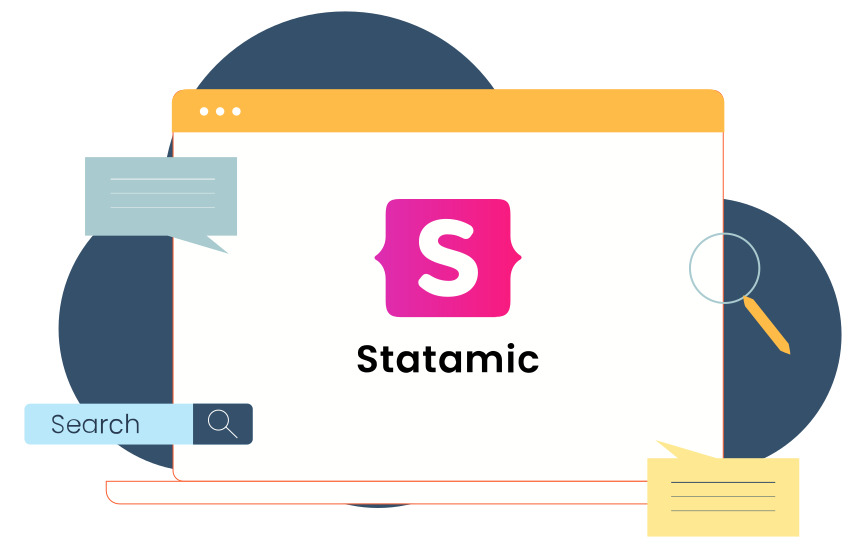Exploring the Power of Statamic: Building Dynamic Websites with Ease
 Hire Remote Developers
Hire Remote Developers
I. Introduction
Statamic is an incredibly powerful content management system (CMS) that allows you to build dynamic websites with ease. Unlike traditional CMS platforms, Statamic offers numerous benefits that make it a popular choice for developers and content creators alike. In this blog post, we will explore what Statamic is and why it's worth considering for your next web project. Whether you're a beginner or an experienced developer, this article will provide an easy-to-understand overview of Statamic's capabilities and how it can simplify the process of building dynamic websites.
II. What is Statamic?
A. Definition and Explanation of Statamic: Statamic is a modern and flexible content management system (CMS) designed to simplify the process of building dynamic websites. Unlike traditional CMS platforms, Statamic utilizes a file-based approach, where content is stored as flat files rather than in a database. This unique structure allows for faster performance and easier version control.
B. Key Features and Advantages of Statamic over Traditional CMS Platforms:
Simplicity: Statamic offers a user-friendly interface and a straightforward setup process, making it accessible even for non-technical users.
Flexibility: With Statamic, developers have the freedom to structure and organize content in a way that best suits their needs, thanks to its file-based architecture.
Customization: Statamic provides a robust templating language that allows developers to create dynamic, personalized websites with ease.
Performance: The flat-file storage system and built-in caching mechanisms contribute to faster loading times and improved website performance.
Version Control: Statamic's file-based approach makes it effortless to manage content revisions and rollbacks.
C. Comparison with Other Popular CMS Options: While popular CMS platforms like WordPress and Drupal have their own strengths, Statamic stands out with its simplicity, flexibility, and performance. Unlike WordPress, Statamic doesn't require a database, which simplifies the setup process and enhances security. Compared to Drupal, Statamic offers a more intuitive user interface and a smaller learning curve, making it an attractive choice for developers and non-technical users alike.
Whether you're a statamic development company or an individual seeking statamic development services, exploring the power of Statamic can open up new possibilities for building dynamic websites with ease.
III. Getting Started with Statamic
Statamic is an incredibly powerful content management system (CMS) that allows you to build dynamic websites with ease. Whether you're a seasoned developer or new to web development, Statamic provides a user-friendly interface and a flexible structure that makes building websites a breeze. In this section, we'll walk you through the process of getting started with Statamic, from installation to setting up your first website.
A. Installation Process and System Requirements To begin your Statamic journey, you need to install the CMS on your local development environment or web server. Statamic has straightforward installation steps, and the system requirements are minimal, making it accessible for various setups.
B. Setting Up a New Website with Statamic Once Statamic is installed, you can start creating your new website. Statamic offers a command-line interface (CLI) that simplifies the process of setting up a fresh project. You can choose from various starter kits or build your website from scratch using the provided templates and content structures.
C. Introduction to the Statamic Control Panel and Its Interface The Statamic control panel is where you manage your website's content, configure settings, and customize the appearance. It features a clean and intuitive interface that allows you to navigate seamlessly through different sections, such as content editing, user management, and addon integration. The control panel makes it easy for non-technical users to update website content and perform various administrative tasks without requiring extensive coding knowledge.
By following these steps and familiarizing yourself with the Statamic control panel, you'll be well on your way to creating dynamic and engaging websites using this powerful CMS.
IV. Building Dynamic Websites with Statamic
Building dynamic websites with Statamic is a breeze, thanks to its powerful features and flexible nature. Whether you're a beginner or an experienced developer, Statamic provides an intuitive and efficient way to create and manage dynamic content. Here are some key aspects to consider when building dynamic websites with Statamic:
A. Creating and managing content using Statamic's flexible data structure:
Statamic offers a flexible and customizable data structure that allows you to organize and manage your content efficiently.
You can create custom fields and structures to suit your specific website requirements.
This enables easy content creation and management, even for non-technical users.
B. Exploring the power of the Statamic templating language:
Statamic's templating language allows you to design and structure your website with ease.
You can use conditional statements, loops, and variables to create dynamic and interactive web pages.
The templating language provides a simple syntax that is easy to understand and work with.
C. Leveraging dynamic routing and URL structures:
Statamic enables you to define dynamic routing and URL structures effortlessly.
This allows for clean and SEO-friendly URLs, enhancing the user experience and search engine optimization of your website.
Dynamic routing makes it easy to create custom page layouts and structures.
D. Implementing custom functionality with Statamic addons and plugins:
Statamic has a vibrant ecosystem of addons and plugins that extend its core functionality.
You can enhance your website by integrating additional features and functionalities.
Whether you need e-commerce capabilities, social media integration, or advanced form handling, there's likely an addon or plugin available to meet your needs.
Building dynamic websites with Statamic empowers developers and website owners to create engaging and interactive online experiences. The flexibility, power, and extensibility of Statamic make it a top choice for businesses seeking professional statamic development services from experienced statamic development companies.
V. Enhancing the User Experience with Statamic
To provide an exceptional user experience, Statamic offers a range of built-in features and tools that streamline user management, enable dynamic forms, and optimize website performance. Here's how you can enhance the user experience with Statamic:
A. Utilizing Statamic's built-in user management and authentication system:
Create user accounts and assign roles and permissions easily.
Secure your website's content by restricting access to specific users or user groups.
Implement user registration and login functionality for personalized experiences.
B. Implementing dynamic forms and contact pages:
Use Statamic's form builder to create dynamic forms for various purposes.
Collect user data, feedback, or inquiries through contact forms.
Customize form submission notifications and automate responses.
C. Optimizing website performance with caching and asset management:
Leverage Statamic's built-in caching mechanism to boost website speed and reduce server load.
Utilize asset management features to efficiently handle and optimize images, CSS, and JavaScript files.
Implement caching strategies for dynamic content to enhance performance.
By utilizing these features, you can create a seamless user experience with Statamic, ensuring smooth user interactions, personalized content delivery, and optimal website performance.
VI. Extending Statamic Functionality
Statamic is a versatile content management system (CMS) that allows developers to extend its functionality through various means. Here are some key ways to enhance and customize Statamic to suit your specific needs:
A. Exploring the Statamic addon marketplace:
The Statamic addon marketplace offers a wide range of pre-built addons that can be easily integrated into your website.
These addons provide additional features and functionalities, such as galleries, e-commerce capabilities, SEO optimization, and more.
You can browse the marketplace to find addons that align with your project requirements and install them with just a few clicks.
B. Integrating third-party services and APIs with Statamic:
Statamic allows seamless integration with third-party services and APIs, expanding the capabilities of your website.
You can integrate services like payment gateways, email marketing platforms, analytics tools, and social media platforms to enhance user experience and streamline workflows.
This integration enables you to leverage the power of external services while still enjoying the flexibility and ease of use provided by Statamic.
C. Developing custom addons and extending Statamic core functionality:
For advanced customization needs, you can develop custom addons to extend Statamic's core functionality.
By writing custom code, you can create unique features tailored to your specific requirements.
You can develop custom addons for additional functionality, integrations, or enhancements to the existing features of Statamic.
If you require assistance with Statamic development, you can seek the services of a Statamic development company. They can provide expert guidance and support in extending Statamic's functionality to create a customized and powerful website.
VII. SEO and Statamic
Optimizing your Statamic website for search engines is crucial to improve its visibility and drive organic traffic. With Statamic's built-in SEO tools and features, you can easily enhance your website's search engine performance. Here are some best practices to follow and features to leverage:
A. Best practices for optimizing Statamic websites for search engines:
Conduct keyword research and integrate relevant keywords into your content.
Optimize your website's loading speed for better user experience and search engine ranking.
Ensure your website is mobile-friendly and responsive.
Create unique and descriptive meta titles and descriptions for each page.
B. Using Statamic's built-in SEO tools and features:
Utilize SEO-friendly URLs that include keywords and are human-readable.
Customize meta tags for individual pages using Statamic's simple interface.
Generate XML sitemaps to help search engines discover and index your website.
Implement canonical URLs to avoid duplicate content issues.
C. Implementing metadata and structured data in Statamic:
Add relevant metadata such as schema.org markup to provide search engines with more context about your content.
Utilize Statamic's flexible content structure to include structured data elements like reviews, ratings, and product information.
Ensure your website's HTML markup follows best practices for accessibility and structured data implementation.
By following these SEO best practices and leveraging Statamic's SEO tools and features, you can improve your website's visibility in search engine results, attract more organic traffic, and enhance your overall online presence.
VIII. Conclusion
Building dynamic websites with Statamic offers a powerful and user-friendly experience. Throughout this blog, we've explored the key features and advantages of Statamic as a content management system. By utilizing its flexible data structure, robust templating language, and dynamic routing capabilities, developers can create dynamic and engaging websites with ease.
In conclusion, Statamic empowers web developers to build websites that are customizable, scalable, and efficient. Whether you're a beginner or an experienced developer, exploring Statamic for your future web projects is highly encouraged. Its intuitive interface, extensive documentation, and vibrant community make it a valuable tool for creating dynamic websites that truly stand out. Give Statamic a try and unlock the full potential of your web development endeavors.
Subscribe to my newsletter
Read articles from Hire Remote Developers directly inside your inbox. Subscribe to the newsletter, and don't miss out.
Written by

Hire Remote Developers
Hire Remote Developers
Hi, I am Mukesh Ram I founded Acquaint Softtech with a vision to make quality developers affordable to everyone. With my blood, sweat, and tears I haven’t just been able to sustain but thrive over the years. Today, I am proud to say that we have grown to a family of over 70 awesome people and expanding quickly. Every day I look forward to uniting with my professional family to provide them the best environment to grow their careers and propel us towards fulfilling the vision of Acquaint Softtech. And crack jokes in between! On a personal front, I am a foodie and a life enthusiast who loves to live each moment to the fullest.